Heart-lung machines, also known as cardiopulmonary bypass machines, are incredible medical devices that play a crucial role in life support systems. These machines assist in oxygenating and circulating blood during surgeries that involve stopping the heart. As a vital component of life support, heart-lung machines have revolutionized the field of medicine and continue to be integral to advancements in surgical and critical care practices. In this topic cluster, we will delve into the fascinating world of heart-lung machines, their compatibility with life support systems, and their place within the realm of medical devices & equipment.
The Pioneering Evolution of Heart-Lung Machines
Heart-lung machines are a testament to the remarkable progress in medical technology. In the mid-20th century, the development of these machines transformed the landscape of open-heart surgeries, allowing surgeons to perform intricate procedures that previously seemed impossible. The ability to temporarily take over the functions of the heart and lungs empowered surgeons to repair cardiac defects and conduct complex interventions with greater precision and safety.
Dr. John Gibbon, a pioneering surgeon, is credited with the invention of the first heart-lung machine in 1953, marking a watershed moment in the history of medical devices. Since then, continuous innovation and refinement have enhanced the capabilities and reliability of these machines, making them indispensable for a wide range of cardiac and thoracic procedures.
The Mechanics of Heart-Lung Machines
Heart-lung machines perform a remarkable feat - they temporarily replace the functions of the heart and lungs, enabling surgeons to operate on a motionless, bloodless field. The machine diverts the patient's blood from the body, oxygenates it, removes carbon dioxide, and then pumps it back into the circulatory system. This intricate process allows surgeons to perform intricate procedures on a still heart, reducing the risk of damage and complications.
Modern heart-lung machines are equipped with advanced monitoring and control systems, ensuring precise regulation of blood flow, oxygenation, and temperature. This level of control is instrumental in maintaining stable physiological conditions during complex surgeries, ultimately contributing to improved patient outcomes.
Compatibility with Life Support Systems
Heart-lung machines are at the forefront of life support systems, playing a pivotal role in sustaining patients' vital functions during cardiac and thoracic procedures. By temporarily taking over the heart and lung functions, these machines ensure that oxygenated blood continues to reach vital organs, preserving tissue perfusion and preventing organ failure. Furthermore, the integration of heart-lung machines with other life support technologies, such as intra-aortic balloon pumps and extracorporeal membrane oxygenation (ECMO), provides comprehensive support for critically ill patients.
Moreover, heart-lung machines are integral to the success of organ transplantation procedures, where they facilitate the preservation and transport of donor organs, extending the window of viability and enhancing transplant outcomes. The compatibility of heart-lung machines with life support systems extends beyond the operating room, encompassing critical care units and emergency response settings where rapid intervention is essential.
Heart-Lung Machines within the Landscape of Medical Devices & Equipment
Within the realm of medical devices & equipment, heart-lung machines are renowned for their intricate design and sophisticated functionality. The convergence of engineering, physiology, and medical science has given rise to cutting-edge heart-lung machines that embody precision, reliability, and safety. The continuous evolution of these machines reflects the collaborative efforts of multidisciplinary teams, including clinicians, engineers, and researchers, to propel medical technology forward.
Furthermore, the development of portable and miniaturized heart-lung machines has expanded the scope of their application, enabling complex cardiac procedures to be performed in diverse clinical settings. The adaptability and versatility of these machines underscore their significance as indispensable medical devices that enhance the capabilities of healthcare professionals and improve patient care.
Conclusion
Heart-lung machines epitomize the intersection of innovation, patient care, and life support systems. As integral components of medical devices & equipment, they have redefined the possibilities in cardiac and thoracic surgeries, significantly contributing to the advancement of modern medicine. By understanding the marvels of heart-lung machines and their compatibility with life support systems, we gain deeper insights into the profound impact of these remarkable devices on patient well-being and surgical innovation.


